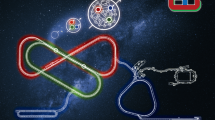Abstract
A polarized ep/eA collider (Electron-Ion Collider, or EIC) with variable center-of-mass energy √s ∼ 20–70 GeV and luminosity ∼1034 cm−2 s−1 would be uniquely suited to address several outstanding questions of Quantum Chromodynamics (QCD) and the microscopic structure of hadrons and nuclei: i) the three-dimensional structure of the nucleon in QCD (sea quark and gluon spatial distributions, orbital motion, polarization, correlations); ii) the fundamental color fields in nuclei (nuclear parton densities, shadowing, coherence effects, color transparency); iii) the conversion of color charge to hadrons (fragmentation, parton propagation through matter, in-medium jets). We briefly review the conceptual aspects of these questions and the measurements that would address them, emphasizing the qualitatively new information that could be obtained with the collider. Such a medium-energy EIC could be realized at Jefferson Lab after the 12GeV Upgrade (MEIC), or at Brookhaven National Lab as the low-energy stage of eRHIC.
Similar content being viewed by others
References
U.S. Department of Energy Office of Science Nuclear Science Advisory Committee’s December 2007 Long Range Plan The Frontiers of Nuclear Science available at: http://science.energy.gov/np/nsac.
Report on the Joint BNL/INT/JLab Program Gluons and the quark sea at high energies: Distributions, polarization, tomography, Institute for Nuclear Theory, Seattle, WA, September 13 -- November 19, 2010, edited by D. Boer, M. Diehl, R. Milner, R. Venugopalan, W. Vogelsang, arXiv:1108.1713 [nucl-th], see also presentations and materials at: http://www.int.washington.edu/PROGRAMS/10-3.
L.W. Whitlow, E.M. Riordan, S. Dasu, S. Rock, A. Bodek, Phys. Lett. B 282, 475 (1992) and references therein.
D. Higinbotham, W. Melnitchouk, A.W. Thomas, J. Phys.: Conf. Ser. 299, 011001 (2011).
Conceptual Design Report (CDR) for the Science and Experimental Equipment for the 12 GeV Upgrade of CEBAF (Prepared for the DOE Science Review, April 6--8, 2005), edited by J. Arrington (Jefferson Lab, 2005) available at: http://www.jlab.org/div_dept/physics_division/GeV/doe_review/CDR_for_Science_Review.pdf.
M. Klein, R. Yoshida, Prog. Part. Nucl. Phys. 61, 343 (2008).
H. Abramowicz, A. Caldwell, Rev. Mod. Phys. 71, 1275 (1999).
M. Burkardt, A. Miller, W.D. Nowak, Rep. Prog. Phys. 73, 016201 (2010).
S.E. Kuhn, J.-P. Chen, E. Leader, Prog. Part. Nucl. Phys. 63, 1 (2009).
V. Barone, F. Bradamante, A. Martin, Prog. Part. Nucl. Phys. 65, 267 (2000).
G. Bunce, N. Saito, J. Soffer, W. Vogelsang, Ann. Rev. Nucl. Part. Sci. 50, 525 (2000).
In the interest of a concise summary we refer here mostly to review articles of the individual physics topics. References to original results and further information on the individual topics can be found in the cited literature.
For information and updates on Lattice QCD, see resources at: http://www.usqcd.org/.
S. Kumano, Phys. Rep. 303, 183 (1998).
G.T. Garvey, J.-C. Peng, Prog. Part. Nucl. Phys. 47, 203 (2001).
S.J. Brodsky, arXiv:1202.5338 [hep-ph].
HERMES Collaboration (A. Airapetian et al.), Phys. Lett. B 666, 446 (2008).
D. de Florian, R. Sassot, M. Stratmann, W. Vogelsang, Prog. Part. Nucl. Phys. 67, 251 (2012).
M. Diehl, Phys. Rep. 388, 41 (2003).
A.V. Belitsky, A.V. Radyushkin, Phys. Rep. 418, 1 (2005).
S. Boffi, B. Pasquini, Riv. Nuovo Cimento 30, 387 (2007).
L. Frankfurt, M. Strikman, C. Weiss, Ann. Rev. Nucl. Part. Sci. 55, 403 (2005).
M. Anselmino et al., Eur. Phys. J. A 47, 35 (2011).
U. D’Alesio, F. Murgia, Prog. Part. Nucl. Phys. 61, 394 (2008).
G. Piller, W. Weise, Phys. Rep. 330, 1 (2000).
N. Armesto, J. Phys. G 32, R367 (2006).
L. Frankfurt, V. Guzey, M. Strikman, Phys. Rep. 512, 255 (2012).
F. Gelis, E. Iancu, J. Jalilian-Marian, R. Venugopalan, Ann. Rev. Nucl. Part. Sci. 60, 463 (2010).
P.R. Norton, Rep. Prog. Phys. 66, 1253 (2003).
D.F. Geesaman, K. Saito, A.W. Thomas, Ann. Rev. Nucl. Part. Sci. 45, 337 (1995).
E665 Collaboration (M.R. Adams et al.), Phys. Rev. Lett. 74, 1525 (1995).
HERMES Collaboration (K. Ackerstaff et al.), Phys. Rev. Lett. 82, 3025 (1999).
HERMES Collaboration (A. Airapetian et al.), Phys. Rev. Lett. 90, 052501 (2003).
A. Accardi, F. Arleo, W.K. Brooks, D. D’Enterria, V. Muccifora, Riv. Nuovo Cimento 32, 439 (2010).
PHENIX Collaboration (S.S. Adler et al.), Phys. Rev. Lett. 96, 032301 (2006).
STAR Collaboration (B.I. Abelev et al.), Phys. Rev. Lett. 98, 192301 (2007) 106.
PHENIX Collaboration (A. Adare et al.), Phys. Rev. Lett. 98, 172301 (2007).
For further information and updates on the EIC machine designs, see: https://eic.jlab.org/wiki/ (JLab) and https://wiki.bnl.gov/eic/ (BNL).
For a summary of the projected luminosity of the different EIC designs as of August 2010, see: https://eic.jlab.org/wiki/index.php/Machine_designs.
For information and updates on the LHeC project, see: http://www.ep.ph.bham.ac.uk/exp/LHeC/.
A. Lehrach et al., J. Phys. Conf. Ser. 295, 012156 (2011) for a recent summary of the ENC project.
Author information
Authors and Affiliations
Corresponding author
Additional information
Communicated by M. Anselmino
Rights and permissions
About this article
Cite this article
Accardi, A., Guzey, V., Prokudin, A. et al. Nuclear physics with a medium-energy Electron-Ion Collider. Eur. Phys. J. A 48, 92 (2012). https://doi.org/10.1140/epja/i2012-12092-7
Received:
Accepted:
Published:
DOI: https://doi.org/10.1140/epja/i2012-12092-7



